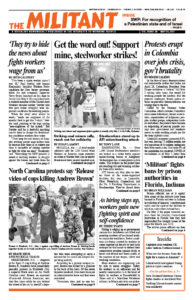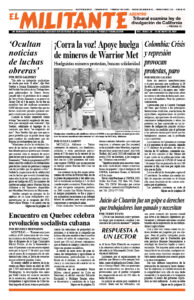May 27, 1996
MIAMI — “How come they didn’t even know that one day this was going to happen? They wait until after this happens and then figure out what to do?” Dionne McClain raised these questions following the crash of ValuJet Flight 592.
Her fiancee was killed in the May 11 crash. All 105 passengers and 5 crew members died in the plunge of the 27-year-old DC-9. In the last two years ValuJet planes have returned to the airport of origin 68 times.
ValuJet is one of 20 “low-cost” airlines operating; some 20 more are waiting to start up. In two years the nonunion airline has grown from 2 to 51 planes. One way ValuJet cuts costs is by farming out maintenance to nonunion contractors, who pay workers much less and require them in some cases to work on many different types of aircraft for quick turnarounds.
May 28, 1971
WELLINGTON, New Zealand — The April 30 New Zealand-wide anti-Vietnam-war demonstrations involved far greater numbers than ever before in opposition to the Indochina war. Protests took place in every major city and many smaller towns, more than 35,000 marched in the streets. The central demand was for the immediate withdrawal of all New Zealand, United States, and allied armed forces from Indochina.
Several trade unions and prominent unionists endorsed the mobilization, and the Seamen’s Union held a national strike in support. This is the first time such action against the war has been taken by unionists in New Zealand.
The mobilization was launched at the highly successful National Antiwar Conference of more than 600 persons in Wellington March 13-14. In many centers entirely new coalitions were built after the conference.
May 25, 1946
The second great strike wave in the post-war upsurge of American labor reached a climactic point last week as the assault against the coal miners and railroad workers mounted in ferocity. President Truman first put pressure upon the UMW leaders to call off their strike for a two-week period and then threatened to issue a government order seizing the mines in the event that the strike was resumed.
The demonstrative walkout of the railroad workers in the face of the truce order tied up the entire transportation system for several hours. Over 25 percent of mine workers in the key Western Pennsylvania area refused to return to the pits without a signed contract.
The most important lesson of the strike struggles is the urgent need of the unions to sever their ties with the capitalist-dominated Republican and Democratic machines.

